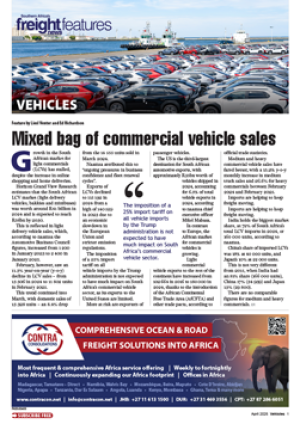The SA Revenue Service
(Sars) pilot scheme
based at SACD Freight
in Durban – aimed at a
return to the old-style
on-premises container
inspections – has worked
very smoothly in its first
few weeks of operation,
according to Lee Narsey,
IT specialist at SACD.
“The new procedure,
with an on-site customs
team, has greatly increased
the number of inspections
that customs have been
able to attend to each day,
compared to the couple
of hours each morning
they used to spend at the
depot,” Narsey told FTW.
“Also, they have direct
wireless contact with the
Sars service manager
inspection system through
their I-pads when based at
SACD.
“In terms of numbers,
we’re certainly getting a
faster turnaround.”
Narsey said that the
new initiative was also
making SACD’s internal
preparations for container
inspections much easier.
“Sars has been alerting
us in advance so we’re able
to make the appropriate
arrangements – allowing
us to place the containers
in the appropriate parts
of the warehouse, and to
allocate in advance the
necessary work teams for
either an unpack/repack or
a tailboard inspection,” he
added.
And that’s a rather
crucial difference.
The full unpack is a
time-consuming, labourintensive
operation,
and has to be done in
a secured facility. For
these reasons a first level
search is done only on
high-risk or suspicious
consignments. However
Sars feels it is the most
effective means of
detection of contraband.
The so-called tailboard
inspection is when the
container doors are opened
for an examination of only
the first one or two rows
of goods. The contents of
the rest of the container
are not unloaded.
It is estimated that only
3% of goods are physically
inspected after being
screened by tailboard
inspections or random
spot checks.
The next step in the
scheme is the roll-out
to the plethora of other
depots around the country.
But this is not going to
be an easy exercise – and
there’s some debate about
when this will actually
take place.
The major problem at
depot level is the vastly
varying sizes of each of
them. There are the big
depots that would make
an in-house customs team
a viable proposition –
and all within spitting
distance of each other.
But, more widespread,
are all the much smaller
operations, and these
hardly have the numbers
to justify a customs team,
nor the spare cash to
finance premises and their
services for the inspectors.
That throws a problem
at Sars. And along
with that, according to
members of the freight
industry, is the relatively
low skills-level of customs
inspectors – which makes
skills training in the
wireless connectivity and
equipment of the new
initiative a vital concern
for Sars.
All of this makes
planning for the roll-out
a slow and necessarily
complex issue, with all
the problems having to
be carefully worked out
before a date for roll-out
can de decided.
This was revealed at
last week’s Sars forum
in Durban – a regular
get-together with the
freight industry, which
is designed to sound out
the various activities and
problems at customs, and
between them and sectors
of the industry.
INSERT
The major problem
at depot level is the
vastly varying sizes of
each of them.

